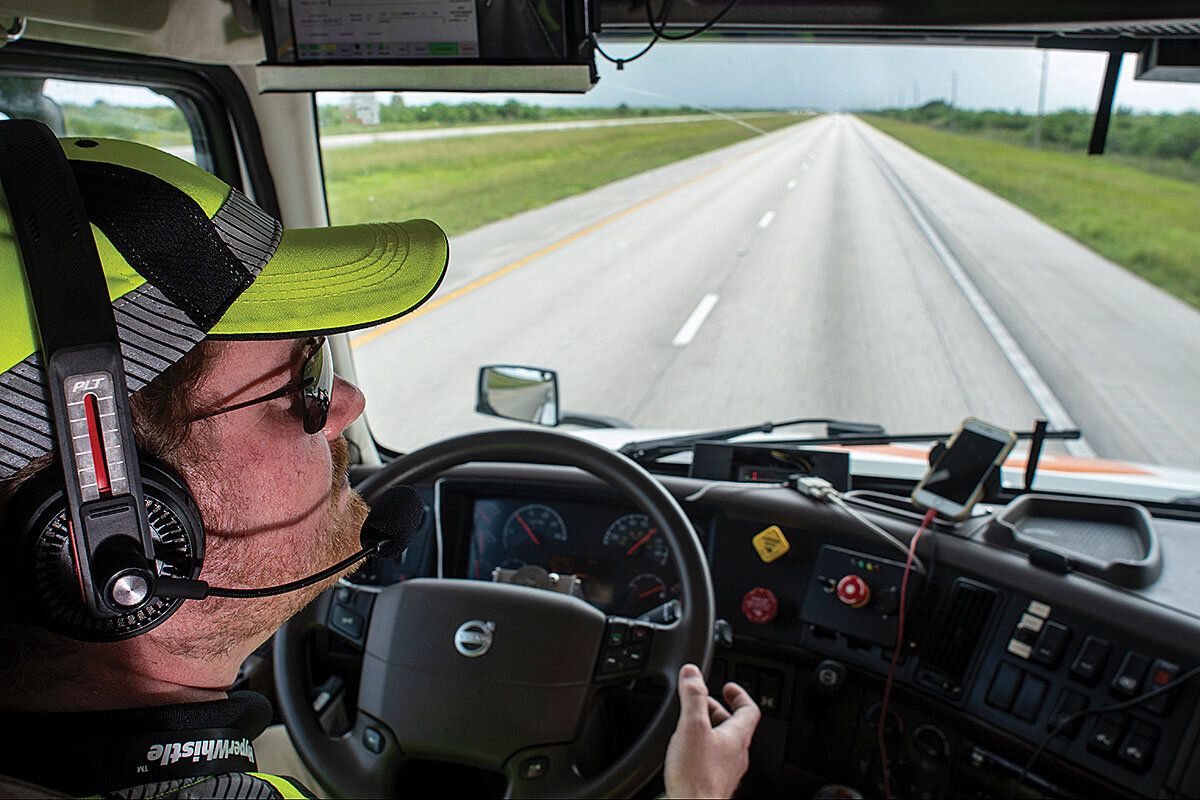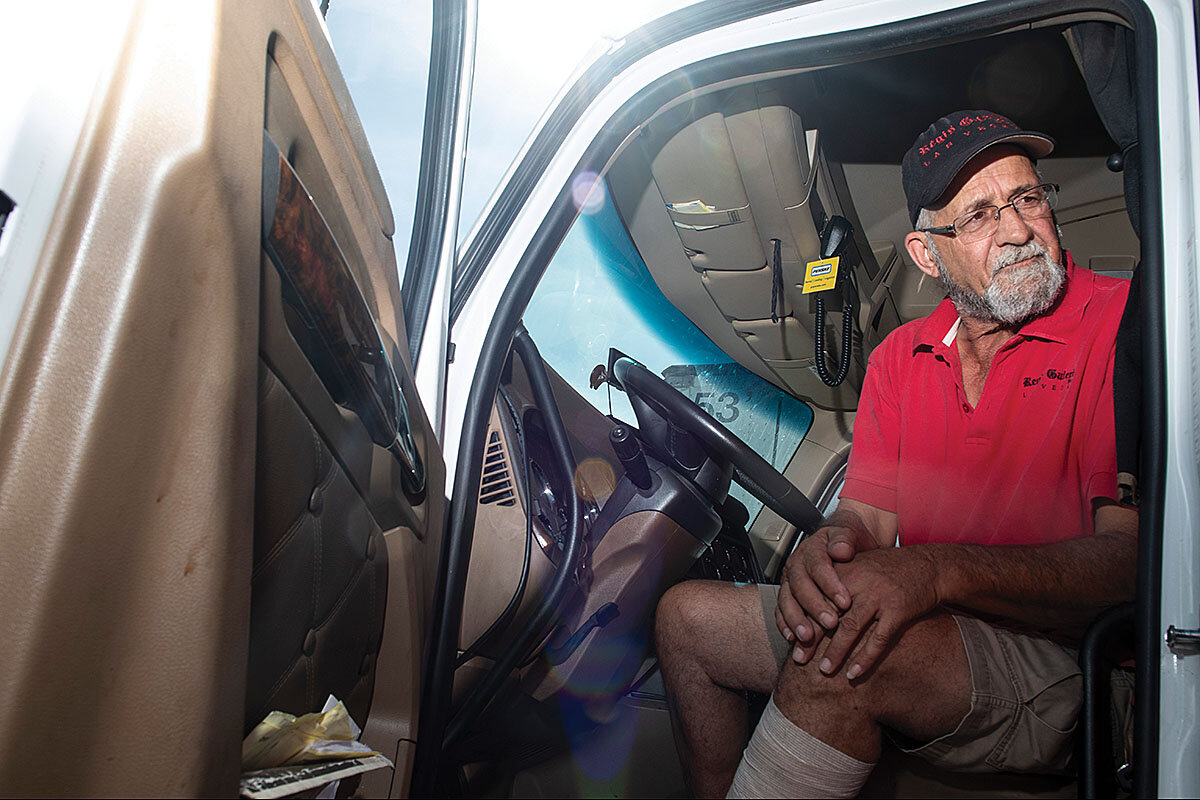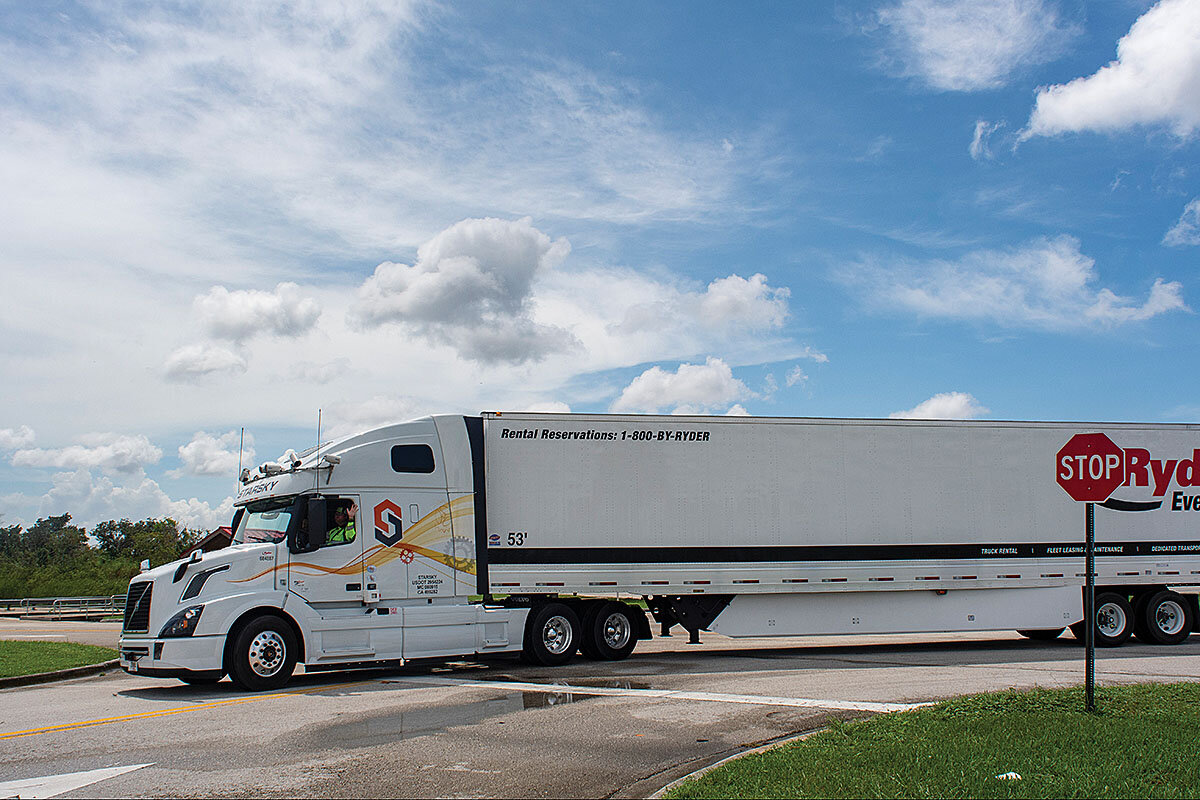Self-driving trucks in US offer window into where machines may replace humans
Loading...
| POMPANO BEACH, Fla.
On a muggy morning, Matt Brauneck noses his semi with its 53-foot trailer out of the yard, past the puddles left by a tropical storm. From his driver’s seat in the cab he has a clear view of the road and of the light suburban traffic leading to Interstate 75 in southeastern Florida. Atop the pearly-white cab are six cameras and three radar sensors that are feeding data to a computer stack behind Mr. Brauneck’s seat and to a remote operating base in Jacksonville, Fla., 300 miles away. Brauneck’s boss, Stefan Seltz-Axmacher, the head of a small robotics company, is wedged in the back. I’m sitting up front.
And we’re about to turn over command of 16 tons of aluminum and steel to an algorithm.
After the truck eases onto the highway, Brauneck talks into his headset to the technicians in Jacksonville. Ten minutes later he gets the all-clear: Time to engage automation. He turns a cracker-sized red knob on the dashboard and flicks a switch. “We’re rolling. It’s on,” he says.
Why We Wrote This
The march of tech innovation keeps delivering boosts, and blows, to people whose jobs can partly (or entirely) be done without their input. This piece looks at a very human line of work and at the value of being deliberate about pacing progress.
Brauneck lifts his hands from the wheel, which jerks occasionally to correct our path. The accelerator pedal at his feet is working itself up and down, or so it seems, as we cruise along I-75. Brauneck says the first time he “drove” a truck in automation it felt like the first time he scuba dived. Like breathing underwater, “it didn’t feel right,” he says. Now it’s routine for him.
Yet it’s not routine for me. I can’t stop watching the twitching wheel. Outside, the narrow highway shoulder is hemmed by a 10-foot fence to keep out alligators from the surrounding swampland. I see vultures wheeling overhead – seriously.
Welcome to tomorrow on the nation’s highways. Your local truck stop is one of the latest places where machines may soon replace jobs now done by humans.
For decades, robotic devices have been remaking the world of work, principally on the factory floor. They build our cars. They fetch our TVs and toasters in massive consumer warehouses. They weld the turbines used in jet engines.
But with advances in artificial intelligence, machines are poised to invade workplaces that once seemed immune to automation. A 2013 study by Oxford University found that fully 47 percent of jobs in the United States were at risk of being automated based on existing AI and robotics capabilities.
Transportation is one of the key areas where machines are on the march. People are both captivated – and frightened – by the prospect of self-driving cars pulsing through the nation’s streets. But for all the hype about automated cars, trucks may well begin hauling freight along highways, without the grizzled trucker at the wheel, first. Highway driving is more straightforward to automate than unpredictable urban driving and holds the promise of lower fuel costs, higher productivity, and improved safety.
Automated trucking is already a reality in remote mines and logging camps, and the US military has built its own robo-trucks to deploy in war zones. Volvo recently unveiled a prototype of an electric self-driving truck that doesn’t even have a cab for a driver.
While all this represents progress to many people, others worry about a looming loss of jobs. Andrew Yang, an entrepreneur and author of a book on automation, says AI could replace millions of semi-skilled humans in industries from fast food to retail. No job is immune, not even in white-collar fields such as accounting, insurance, and pharmacology.
“People talk about this as if it’s speculative and in the future, and we’re in the midst of it,” says Mr. Yang.
That warning may be premature – or prescient. What can the trucking industry tell us?
***
Sandwiched between two dump sites on the approach to Fort Lauderdale Airport, Florida 595 Truck Stop does not appear on any tourist maps. It’s a 50-acre expanse of cracked asphalt and gas pumps and green aluminum-sided buildings in the lee of a tangle of rumbling highways.
For truck drivers in South Florida, it’s an essential stop. It offers fuel and food, medical checkups and citizens band radios, drinks and banter at a cash-only bar, and showers in the back. There are 24-hour parking bays for more than 400 semis and buses. By some estimates it’s one of the country’s largest truck stops, servicing around 80,000 big rigs a year.
In a majority of US states, driving is the most common occupation, and of these workers who drive for a living more than 2 million operate heavy and tractor-trailer trucks. Long-haul truckers occupy an enduring place in popular culture – the romantic myth of the open road, with all its freedoms and rewards. After all, in what other industry do working-class people get paid to travel cross-country in mighty machines, setting their own hours and bonding with other roughneck road warriors at lonesome stops?
On a recent morning, Euripides “Ricco” Efthimiou sits outside on a plastic bench at the 595 stop, drinking coffee from a paper cup. Gas and diesel fumes waft over from the line of pumps. Mr. Efthimiou, who wears khaki shorts and a polo short, has an hour to kill before making a delivery in Miami in his truck, in which he slept the previous night.
Efthimiou started driving in 1982, and for most of his career he owned and operated his own rig. “Every five years I got a new truck,” he says. The best rates were for hauling equipment for the US military.
In the 1990s, for-hire driving became less lucrative. Efthimiou later sold his truck and took a job as a salaried driver for a luxury-goods store in Las Vegas.
If he had to start over, he’s not sure he’d do it again. “I tell these young kids now if you’re homesick don’t do it because this job, driving a truck, it can make you but it can break you,” he says.
Most long-haul drivers work for regional or national trucking companies who pay per-mile rates that to the uninitiated appear to offer a path to middle-class security. Signs at truck stops advertise 70 cents a mile to qualified drivers. But once you factor in mandatory rest periods and loading and other unpaid downtime, say truckers, the hourly pay for driving 100,000 miles or more a year, spending weeks away from home, works out to barely minimum wage.
The average truck driver makes $42,000 a year, above the median national wage, but less in real terms than truckers earned back in the 1980s when trucking was still heavily unionized. Reagan-era deregulation drove down labor costs and spawned a cutthroat long-haul industry that has become more exploitative and antisocial, making it harder to recruit and retain drivers.
The industry is perpetually short of drivers, says Steve Viscelli, a sociologist who drove a truck for six months while researching his 2016 book, “The Big Rig: Trucking and the Decline of the American Dream.” American Trucking Associations puts the current shortfall at 50,000 drivers.
Mr. Viscelli says the big challenge is retention: Annual turnover at many trucking firms is 100 percent or more. “You just can’t keep people in these jobs,” he says.
Some truck drivers earn more. Parcel companies and private companies such as Walmart pay their drivers $60,000 to $70,000 a year, plus benefits, and turnover is lower. As for the allure of the open road, Viscelli found few true believers. “They will tell you, ‘Oh my God, the boredom of it. Mile after mile, and nothing to see.’ ”
***
The first time Mr. Seltz-Axmacher, the robotics chief executive officer, went to a truck factory he was a college freshman working at an auto parts manufacturer. It was the winter of 2008-09 and the global economy was reeling. But at the Mack Trucks plant in Allentown, Pa., all that Seltz-Axmacher could see were rows of gleaming semis.
He started asking questions. How much was a new truck? $150,000, give or take. The Mack official giving him the tour told him that most of the buyers were individual drivers. Wow, thought Seltz-Axmacher. Trucks cost as much as a Lamborghini. How can a truck driver afford a Lamborghini?
The company official then told him that truck drivers who own their rigs can make $150,000 in a year. Another double take from Seltz-Axmacher. “It turns out that that’s a big lie, a great way of duping the working class into driving trucks,” he says.
But at the time, the economics of hauling freight both fascinated and puzzled Seltz-Axmacher, who was a business major at Drexel University in Philadelphia. Several years later, in the summer of 2015, he was driving back from a weekend hike with his roommate, who built robots and had just quit his job. Seltz-Axmacher was working at a start-up in San Francisco.
What if you could drive a truck remotely? Seltz-Axmacher wondered aloud. Wouldn’t that be a better way to run a fleet? It was the seed of a business plan that became Starsky Robotics, which has since raised more than $20 million to develop its prototype trucks.
While his goal is to build driverless trucks that can haul freight on highways, Seltz-Axmacher still sees a role for drivers, who would handle tricky road situations and the final mile off the highway to a distribution hub, similar to a ship pilot guiding a tanker into harbor. Then they can clock off and go home to their family.
“Robots only make sense [in trucking] where there are labor shortages,” Seltz-Axmacher says. “Where they really shine is where you have to pay a lot of money to get a human to do something and you still can’t get a human to do it.”
Seltz-Axmacher has brown curly hair, small blue eyes, and a reddish beard. On the day of our test drive he wears shorts, flip-flops, and a gray-green Starsky Robotics T-shirt.
Florida is one of several US states that allow self-driving cars and trucks and is among the most flexible in regulating them. In Nevada, operators must put vehicles through 15,000 miles of testing before they can go on public roads. Florida makes no such demands: Starsky doesn’t even need a state permit. (The company also tests in California, which has much tighter rules.)
In February, a Starsky truck drove eight miles on a closed rural road in Florida without a driver on board, a first. Seltz-Axmacher
was filming from a car. “I was thinking, ‘If this thing jams on the accelerator I’m toast,’ ” he says, laughing.
For now, on public roads like today’s ride on I-75 through the Everglades, a safety driver such as Brauneck sits in the rig. Brauneck grew up in Palatka, a small mill town in central Florida, where he worked as a radio announcer in high school. A former TV repairman, he turned to trucking after the economy tanked in 2008 and hauled freight across 48 states.
“I loved being on the road,” he says. “I got to tour the country for free.”
As a driver for a driverless start-up, Brauneck is effectively working to eliminate his old job. He demurs at that description. What he’s doing, he says, is getting on the right side of evolution. “There’s always going to be a need for truck drivers,” he reasons. “You’re going to have to be at a higher level.”
***
How many truckers will ultimately be displaced by technology is a vexing question.
Seltz-Axmacher and other self-driving advocates say that the automation of long-haul trucking will lead to increased net demand for drivers as freight becomes cheaper. As more automated trucks ply interstates, more human drivers will be needed to deliver the loads that robo-trucks carry between dedicated distribution hubs.
Then there’s the job of driving robo-trucks remotely over the last mile using cameras and radars and other sensors, just as a drone pilot at a US military base flies the pilotless aircraft over Afghanistan.
For a glimpse of that future, I watch Brauneck disengage his automation system and exit I-75 and stop in a service center. Jeff Runions, the remote operator in Jacksonville, sits at a console with three monitors relaying images from the truck. I climb out of the cab and watch the truck, under Mr. Runions’s control, make wide turns around the lot, braking at stop signs and backing into bays.
When we’re ready, Runions steers the truck out of the lot and back onto the highway where we will engage automation. All the time, Brauneck is at the wheel, talking into his headset. But his hands are at his side. The truck is being remote-controlled, like a kid’s toy.
Backing up 53-foot trailers in narrow lots is just one of the skills that truck drivers must master – and another reason many drivers scoff at the idea that their jobs could be automated.
“You’re always going to need someone to drive a truck,” says Scott Carder, who lives in Leesburg, Fla. A high school dropout, he’s been driving long-haul for 18 years. In a good year, he says, he pulls in $70,000.
But for every entrepreneur seeing a bright future for truckers, there are other scenarios in which Mr. Carder is on the scrapheap, along with many other drivers.
A report last year by the International Transport Forum estimated that driverless trucks could cut demand for human drivers in Europe and the US in half by 2030. A 2016 White House report said that AI-enabled automation could change or eliminate the jobs of as many as 3.1 million car, truck, and bus drivers.
For decades, advances in technology have delivered unimaginable levels of wealth and material progress, from mechanized farming to factory automation to cloud computing. They have also laid waste to entire occupations that machines could do better or cheaper.
Optimists point to the transition made more than a century ago from agriculture, in which half the US population worked at the time, to industrial production and services. The elimination of farmhands was more than offset by demand for workers in new jobs.
“Every wave of automation, every productivity gain that we’ve had as a species, has always affected the status quo,” says Seltz-
Axmacher. “In the long term, self-driving trucks will ultimately have the same effect.”
Yang, who is seeking the Democratic presidential nomination in 2020, argues that society simply isn’t prepared for the scale and pace of AI-related job elimination. This includes millions of truck drivers who he fears lack the skills and education to find decent paying jobs, particularly when retail and other service industries are also being remade by technology.
“You can’t think of a new industry that’s going to need hundreds of thousands of high school graduates,” says Yang, whose book is titled “The War on Normal People: The Truth about America’s Disappearing Jobs and why Universal Basic Income is Our Future.” “No one can think of one.”
In a joint report for the UC Berkeley Center for Labor Research and Education and the Silicon Valley group Working Partnerships USA, Viscelli, the sociologist, estimates that automation could replace 294,000 long-distance drivers. But he also predicts that it will eventually create more jobs on short-haul routes.
What concerns him most is that the laid-off truckers, particularly those living in rural towns, could end up jobless or, more likely, driving on local routes that pay less.
“We’re going to have plenty of freight-moving jobs in 20 years because of the increase in truck services and delivery services,” he says. “But there’s no evidence that we’re looking at high-quality, high-wage jobs.”
***
Safety is a principal reason boosters of automated driving think the technology is so important to develop. In 2016, more than 4,300 people died in accidents involving large trucks, up 28 percent from 2009. Nearly all road accidents are the result of human error.
Yet safety, legal liability, and public concerns about self-driving make many people skeptical of predictions of imminent automation of trucking or other transportation fields. “It’s a huge leap to take a pilot of a couple of runs a week in a controlled environment and extract from that we’re at a point of commercial viability,” says Jeff Mason, managing director at FreightWaves, an industry publication. “We’re not there yet.”
Even if Seltz-Axmacher is right and robo-trucks are the future, you may not spot them immediately. Self-driving vehicles perform poorly in winter conditions, so the first automated trucks are likely to stick to warmer, less populated routes across the South and West.
Nor is it clear that these trucks will be unmanned. One proposal is that drivers alternate with self-driving systems, sleeping in the back on long highway stretches.
Last year Mack Trucks, the manufacturer that Seltz-Axmacher first visited, launched a new long-distance truck. The Mack Anthem has a radar-equipped collision avoidance system and lane monitoring. It’s also loaded with features designed to ease the driver’s burden, from noise reduction to a roomy sleeping compartment.
What it isn’t designed to do is displace human drivers, says Roy Horton, Mack’s director of product strategy, who is skeptical that self-driving trucks can currently handle the infinite number of variables that drivers face on and off US highways.
“We’re looking to provide solutions that help the drivers to do their job, be more safe, be more productive,” he says.
That’s not how Seltz-Axmacher sees the challenge for the trucking industry. He wants self-driving vehicles to mean just that. “If you still need a person in the truck, you haven’t solved the problem,” he says.
Starsky says it has only had one accident during testing, a rear-ender by another vehicle. The main hazard on highways, says Brauneck, is other drivers who buzz the truck to see how it responds. “I’ve had people slam on the brakes to try to screw us up,” he says.
Seltz-Axmacher’s next goal is to put a driverless truck on a public highway like I-75 without a safety driver, like Brauneck, in the cab. That may be months away and is ultimately a function of human judgment as much as machine learning, a reminder that technological progress is always shaped by social norms.
“I have to balance making us achieve the mission we want to achieve ... and being safe in the here and now,” he says. “If we never move, somebody else will. That somebody else might not put appropriate weight to that decision or think about it the right way.”











